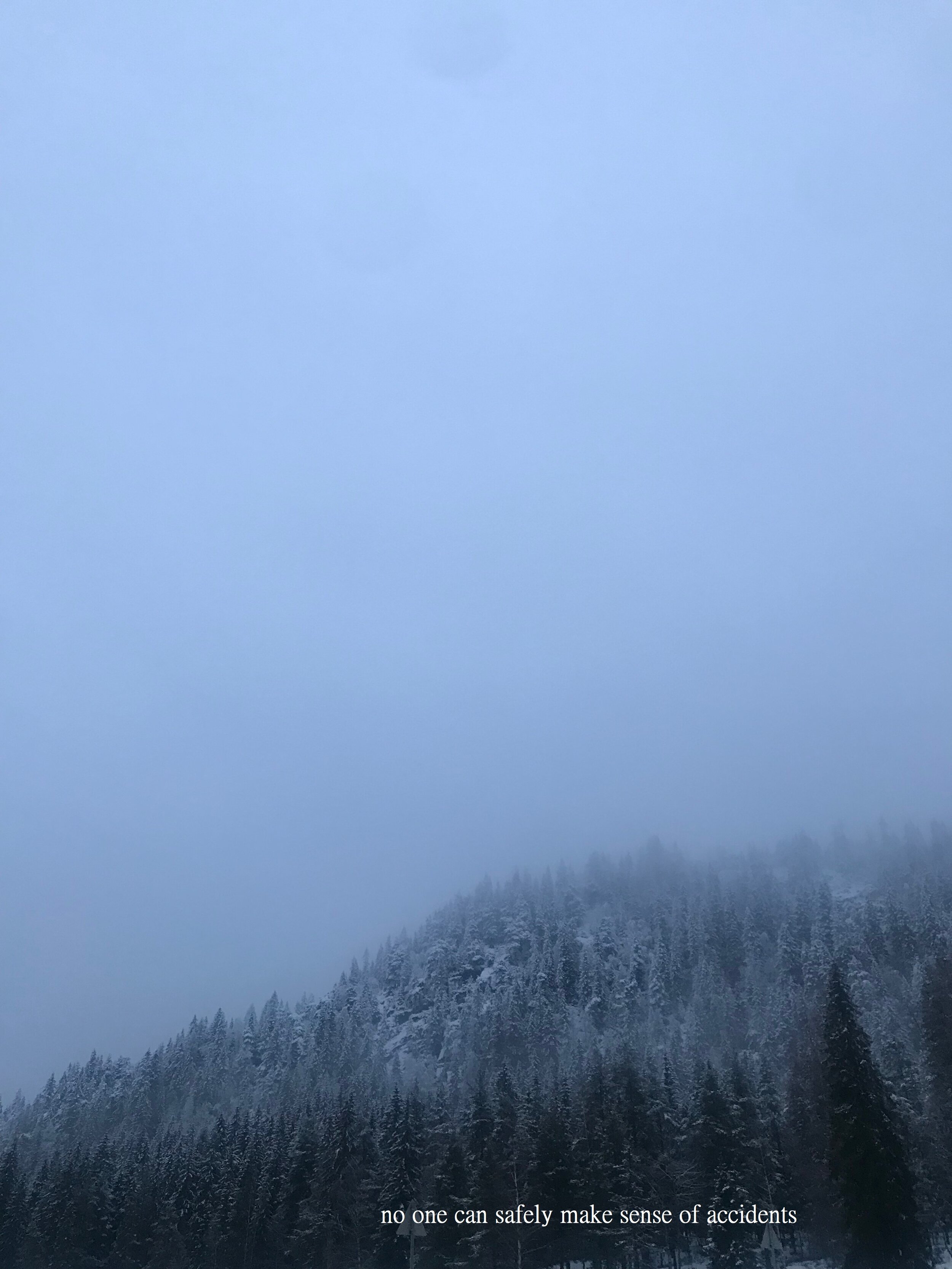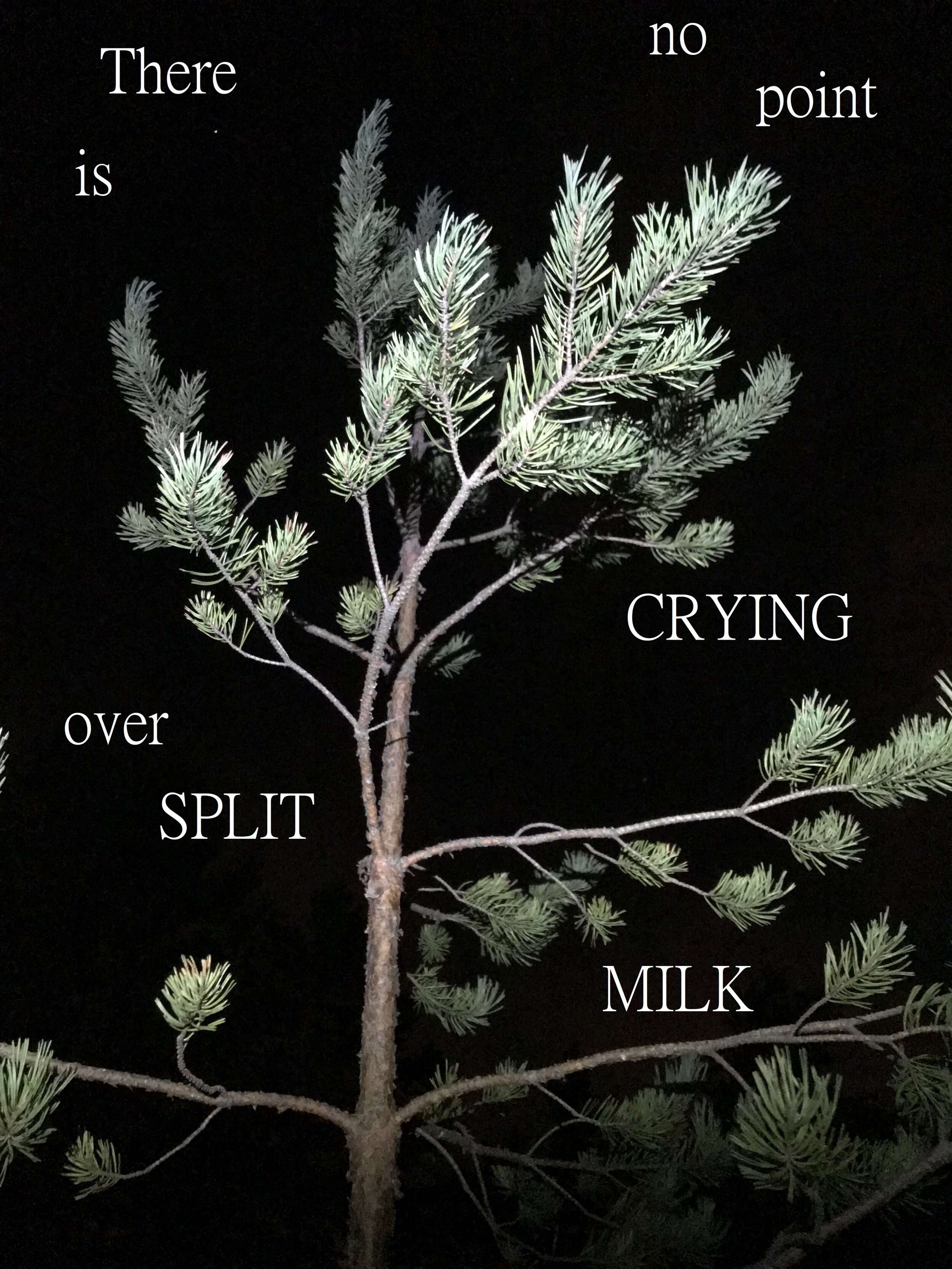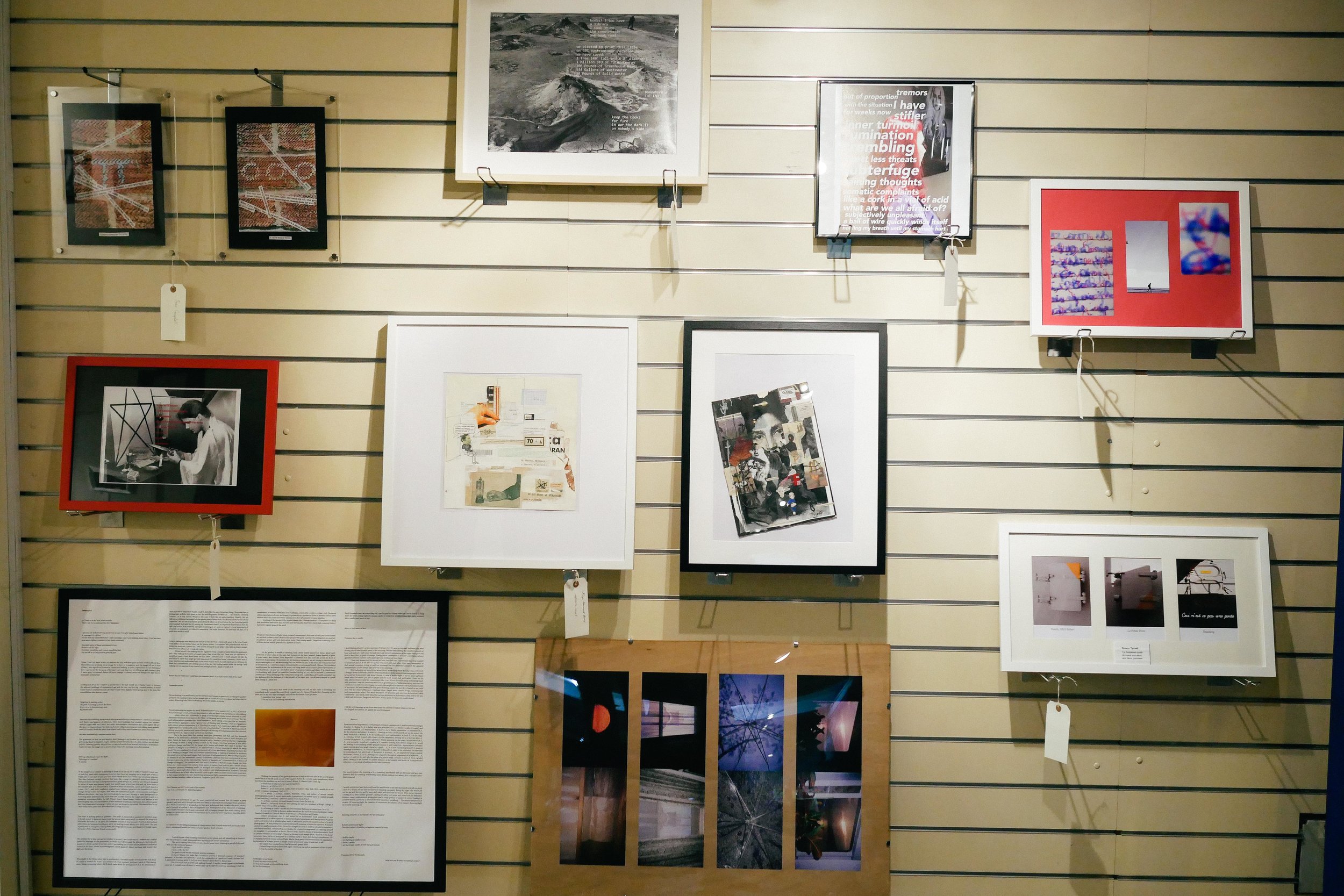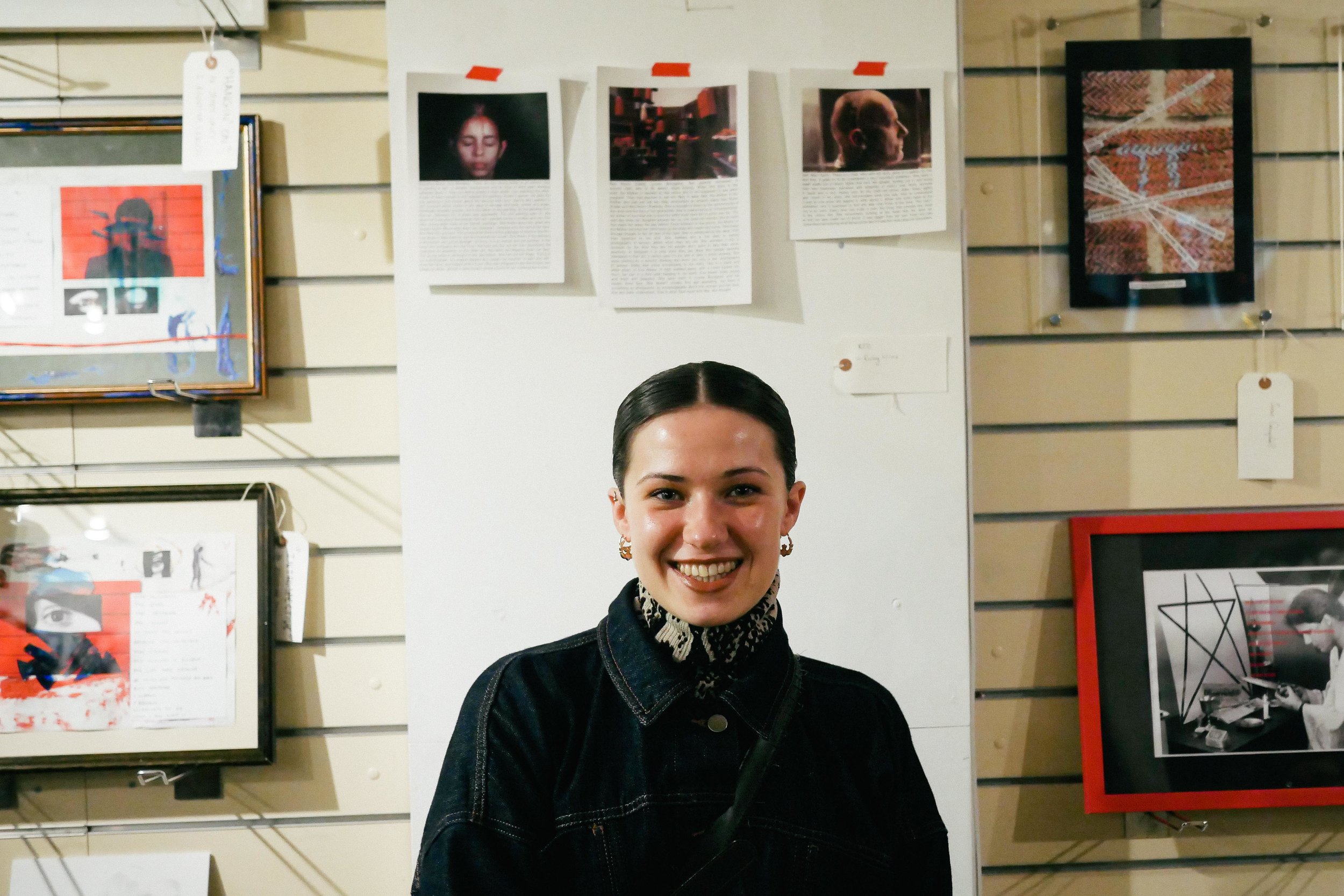Photopoetry
I have tried to define and celebrate this field of visual poetry through publications, courses and commissions.
In 2018, I was commissioned by The Photographer’s Gallery and taught an extensive course entitled The Written Eye, on the subject of Literature and Photography. I was also part of Tate Modern’s writing photographs and curated an exhibition of Poetography at Museum of Futures, Surbiton in 2019. In 2020 I published the photopoetry pamphlet Crowfinger.
My collaborations with photographers - Alexander Kell, Kate Mercer, Matteo Patocchi, Lone Eriksen - have led to publications and exhibitions and in 2021 my selected photopoems will be released with The Aleph / Hesterglock Press.
CROWFINGER December 17, 2020
Crowfinger, by Bård Torgersen and I, is now available from Sampson Low sampsonlow.co/2020/11/23/crowfinger-sj-fowler-and-bard-torgersen/ 36 pages of full colour photopoetry printed in a limited edition of 200. £4.99.
From the publisher “The boldest take on photopoetry and corvids of the last decade, Crowfinger is a book that offers more than meets the eye. Juxtaposing Torgersen’s candid and striking photographs of Norwegian forests with Fowler’s precise and unrelenting poetry, it comes at you like evening fog between the trees." www.stevenjfowler.com/crowfinger
“This is menacing and funny and antic and accusatory and gorgeous and just the best kind of collaboration. It gives us a new way into ekphrasis and a new maze to lose ourselves in. Were you having beautiful thoughts in the beautiful place? Can you just be f*cking honest for once in your life?” Luke Kennard, poet
“The only thing I could compare this book to is going for a run in the forest in the middle of the night. Surrounded by pitch black you hurtle yourself into a little pocket of light whilst trying your best to ignore whatever it is that’s watching you from the shadows. I’m not sure if I read the book or the book read me.” Mikael Buck, photographer
Article for The Photographer’s Gallery
The first article relating to my course The Written Eye is online alongside one of my photopoems from the sochi series I made in Latvia in 2015. https://thephotographersgallery.org.uk/viewpoints/poetry-and-photography-essay
"An exploration of the intersections between poetry and photography is an act of defining terms. It is a process of identification. Of a question. But it does not entail an answer, necessarily. How does one align such disparity between mediums that can only be connected through recourse to metaphors? How does one move past the traditional alignment of image and word that tends to emphasise precisely this dislocation? To begin, we must ask ourselves what these mediums actually are, at heart, and then what they can be together? Finally, what is the purpose of their combination? What can they do together? And why is it relatively rare to see a cohesive combination of the two - with fidelity to poetry that isn’t just text, or discourse, or opinion, and photography that isn’t just pictorial?.........."
The Written Eye : exploring Poetry & Photography at The Photographers Gallery
www.stevenjfowler.com/photographersgallery
https://thephotographersgallery.org.uk/whats-on/course/the-written-eye 25 April - 30 May 2018 in The Photographers’ Gallery
A great pleasure it was to teach a brand new course that explored the post-war traditions of modern photography and avant-garde poetry in both practice and concept in one of the world's foremost institutions of photographic art. From the course description - "As forms of artistic expression, both poetry and photography are apt to convey a narrative or story without certainty or mere description. However both the poetic and the photographic are often still perceived as a solitary acts, occurring in isolation. This course will reveal the connections, potentials and co-habitations of poetry and photography, where collaboration both enhances each medium and evokes what makes them so uniquely compelling. Participants will discover poets from around the world and many photographers who have exhibited at The Photographer’s Gallery as the course covers ideas surrounding composition, language, light, sound, space, printing, narrative and writing, revealing how these practises are fundamental to both arts. Collaborations between the mediums, from Dada to John Berger and Jean Mohr, will be shared and analysed throughout.”
Photo Pedagogy presents Photo Poetry July 12, 2020
Was really happy to contribute to this extraordinary resource on the brilliant Photo Pedagogy project exploring Photo Poetry. https://www.photopedagogy.com/photopoetry.html
The site is for teachers of photography who are happy to share aspects of their practice. The site is about the art (and science) of photography teaching. And what an incredible job Jon Nichols has done with the Photo Poetry section. Really it’s more comprehensive than my resources, which I developed for the Photographer’s Gallery and currently have a 100 slide powerpoint from I subject some students too. It really is worth a dig.
“The term 'photopoetry' and its various alternatives - photopoème, photoetry, photoverse, photo-graffiti etc. - attempts to describe an art form in which the poetry and photography are equally important and, often, directly and symbiotically related…. These correspondences between photography and poetry are brought into sharp relief by photopoetry - specific examples of published collaborations between photographers and poets (sometimes the same person). Writer and artist S. J. Fowler describes the challenge of exploring photopoetry as follows:
To begin, we must ask ourselves what these mediums actually are, at heart, and then what they can be together? Finally, what is the purpose of their combination? What can they do together? And why is it relatively rare to see a cohesive combination of the two - with fidelity to poetry that isn’t just text, or discourse, or opinion, and photography that isn’t just pictorial?
-- S. J. Fowler
Curating the Museum of Futures exhibition - POETOGRAPHY 2019
Course and Article for the Poetry School
Teaching photography and poetry at Poetry School January 31, 2019 Had another generous experience sharing ideas at The Poetry School, this time developing concepts I came up with in 2018 for a course at the photographer’s gallery, and moving them into more practical territory for poets. I spoke a lot about the possibilities of hybridity, and as before, really sought to pick people’s minds on what they thought were the reasons for these two arts overlapping with success so rarely. Some really talented folk in the room, it was a lovely few days down by Canada Water, and like with so many PS courses, I’m sure some of the poets will go on to become friends in the future.
A note on : The Light Room: Poetry & Photography - a course for Poetry School November 24, 2018
Explore the light and dark of poems to develop new ways of seeing
A course that explores the traditions of photography and poetry, entwined. We’ll aim to reach beyond the notions of illustration and response to reveal the connections, potentials, and co-habitations of the two artforms and explore how collaboration can enhance each medium and evoke what makes them so uniquely compelling. Participants will discover poets, photographers and artists from around the world and discuss ideas surrounding composition, language, light, sound, space, printing, narrative and writing. We’ll take inspiration from the work of Blaise Cendrars, Paul Eluard, and Paul Muldoon, alongside Duane Michaels, Wolfgang Tillmans, Tacita Dean, Sophie Calle and John Baldessari, before producing new pieces of your own. This is a chance for poets to develop their own projects and understandings of new and original ways of seeing, reading, and writing. No photography experience is necessary.
Article for the Poetry School https://poetryschool.com/new-courses/the-double-image-of-poetry-and-photography/
Creative mediums are not indefinable. They have essential elements that mean they are not something else at root. But their practise is not best served by recourse to the ‘it is whatever you want it to be’ line of thinking.
I mean, that’s fine, of course – people can think what they like – but does it hold? Is everything whatever we want it to be? Is a poem whatever we want it to be? A photograph? Is my coffee table a photograph? Is my cat a poem? If not (and maybe they are?) then what is it that makes these things what they are or what we understand them to be? The question preoccupies me. It confounds but challenges me. Neither poetry nor photography is quantifiable; not mathematics or science or engineering, this is obvious. But that simply means that definition of these mediums must be subjectively formulated, with real rigour and thought. Perhaps we find out what poetry is when we place it next to and in front of a medium it most definitely is not. Photography, for example, has as little to do with poetry as any creative enterprise might. It requires an external technology to exist. It is painfully recent. It works with light. Nothing is further from language than human perception and the sensation of light.
We might reach for metaphor to describe how the two are alike. They both express an essential experience of the human . . . Yes – maybe, I suppose. But what do they really have in common? They are often juxtaposed as a tennis match: poem–photo photo–poem, back and forth, one then the other. What is the skill of doing this well, beyond having good photos and good poems? What lies beyond the exchange of one with the other? How might we begin with the most difficult (exciting, challenging, beautiful, engaging) task, that is, to align the mediums? How might we fail and succeed? How might we rob from the photo to make our poems visually resonant? How might a photograph think through form, what form really is? What is the language of photography, beyond the loose metaphor? How does poetry engage with framing, perspective, cropping? What might we do with a two-dimensional page that is alive to the three-dimensional trickery that photography suggests?
This course will explore exactly these matters.
This weekend is a product of many questions I have asked of myself, it is the result of many hours talking to photographers and poets, of reading across both mediums, dipping into theory (but not too much of that) and finding artists from fine art, performance, theatre, film, and cinema, who have, in their own way, posed these questions too. It will, if nothing else, offer anyone who enrols provocations that stir, I hope, new ways of seeing the photograph with text, and understanding the poem next to imagery.
More than that, I think, it’ll open doorways to things I can’t conceive of. These will be the answers you provide, new concepts, thoughts, ideas, and above all, actual works – photopoems / phoetry / poemgraphs – that aim to resolve the challenge we’ve set ourselves.
Writing Photographs at Tate Modern : Oct 13th 2018
A powerful day of provocations and workshops led by Beverley Carruthers and Wiebke Leister and the staff of Tate Modern in the Starr Cinema of that institution exploring photographs intersection with the written word. https://www.tate.org.uk/whats-on/tate-modern/exhibition/shape-light/writing-photographs
I had the chance to run a workshop that I turned into a paradox, essentially suggesting most collaborations between poetry (specifically, not text) and photography was a banal tennis match between the mediums, never exploring what is possible between the two precisely because they are so disparate and paradoxical when aligned and this is because no one wants to take a risk / responsibility and stake out working definitions of both mediums in order to fix a creative point of genesis between them. I presented the poor souls in my workshop with six exercises to exacerbate them further, each one designed around impossible, paradoxical tasks that related to photography & poetry / photography & poetry. After this lovely 90 minutes where people wrote some great bursts of work and shared some excellent suspicions I then gave a presentation to the wider group about what we were up to. A good day for me, to further and refine ideas for myself. Photographs by Xiaolin Zhang.
The Museum of Debt : a collaboration with Alexander Kell
The Museum of Debt is an exploration of the unspoken in a contemporary British workplace – most specifically a workplace where the task in hand is the preservation of dead objects – inanimate historical trinkets which pass on their own ossification to their watchmen & watchwomen, and breed a myriad of depressions. Between the concussion of photography and irony of poetries, so the Museum of Debt is about mortality, and a mild form of waking death. Both poet & photographer involved were involved doing the job they documented. A project of internal projection with an innately shared set of meanings and experiences. The photographs were taken then the poems were written.
5 examples of a body of work including about 35 poem / pictures published here https://newcollaborations.wordpress.com/2013/07/14/s-j-fowler-alexander-kell-museum-of-debt/ A selection was also included in Enemies, my selected collaborations (Penned in the margins 2012)
The Night-time Economy : a collaboration with Kate Mercer
An exhibition in Newport: The Riverfront Theatre & Arts Centre April 6th to 30th 2016 and an exhibition in London: Rich Mix Gallery - July 18th to 29th 2016 - A collaborative exhibition of photography and poetry exploring the often fractious energy and environment of Newport, Wales' nightclubs and pubs. Conceived and created in close collaboration between photographer Kate Mercer and poet & artist SJ Fowler, this exhibition will play off the complimentary possibilities for expressive abstraction in both visual and linguistic mediums, all centred around the complexity, energy and intensity of Newport on Friday and Saturday nights. / A detailed description of how the project came to be, by Kate Mercer, can be found here http://katemercer.co.uk/funding-support-by-arts-council-of-wales-the-night-time-economy-with-s-j-fowler/ and an interview with Ben Glover of the Wales Arts Review, which explains further the exhibition and its process can be found here http://www.walesartsreview.org/24536/
From the Newport Opening: April 6th & Rich Mix Gallery London Opening: July 19th 2016
Both Special View events on April 6th and July 19th 2016 featured events celebrating the exhibition with new performances from the likes of Nia Davies, Eurig Salisbury and Marcus Slease, along with the presence of Poetry Wales in Newport. The poetry in the exhibition was presented in English and Welsh, the latter translated by Eurig Salisbury.
ABOUT THE ARTISTS and THEIR COLLABORATION:
From two completely different sides of the UK, S.J. Fowler and Kate Mercer identified with each other through a shared experience of working in the night-time economy. With Steven previously employed in nightclub security, and Kate as a bar manager in Newport, both felt an intense connection to the alternative reality of this world, and through this exhibition, reflect on how this environment changed them and their work. The project's primary focus has been Newport, but not as an exception. The Night-Time Economy reflects Newport without judgement or irony, it is documentation in image and abstract language. With Newport undergoing a period of regeneration and redevelopment, the exhibition aims to recognise the role that the arts can play in celebrating the city, by its very presence. This project focuses on the multifaceted components of Newport's Night-time economy, pursuing a neutrality of topic whilst preserving a loyalty to the place.
This project has been made possible through a ‘Research & Development’ grant by the Arts Council of Wales with support from The Riverfront Theatre & Arts Centre (Newport) and Rich Mix Cinema & Arts Centre (London) for which the artists express their thanks.
Kate Mercer - http://katemercer.co.uk Kate Mercer ’s personal photographic practice explores cultural uses of photography, specifically human relationships with memory and perception through the physicality of photographs. Using both found and self-sourced imagery as starting points, she aims to examine and explore the role of photography as document and self-constructed utopian record. Her work has been exhibited across the UK and abroad. This is her first collaborative project.
Muyock / Twins : Collaborations with Matteo Patocchi
A brilliant Swiss photographer I've collaborated with in London on two projects. Twins features his beautiful innovative portraits of twins surrounding by my long poem for Pussy Riot, about Stalin, Khlebnikov and zygote splitting. He did an amazing job with the typography and an even better job sourcing a printer to render the work as a newspaper, an original format that really embodies the work beautifully. Here's his website http://www.matteopatocchi.com/ and email info@matteopatocchi.com if you want a copy, they are limited edition. Here's also a link to the amazing images in the book http://www.matteopatocchi.com/twins2.html
Muyock, a collaboration based around portraits of Aomi Muyock by Matteo and aberrant responses poems by me was was also included in Enemies, my selected collaborations (Penned in the margins 2012)
The action is thus - collaborating w/ Lone Eriksen May 14, 2013
Lone Eriksen is a Danish photographer of some wonderful capability and skill. She and I met a few years ago before she moved back to Copenhagen, and since then has been a valued link to that city. We first collaborated for Rattle magazine, and then did so again, for our longer piece Brumhold's diary, which took in notion's of photography about photography, novels about novels and which appeared in the following issue of Rattle, and will feature in the Enemies book with penned in the margins. Recently we have often been in touch and have collaborated once again. Lone has a photographer's sense of depth and space, and seems to pick up on my methods before I do, and thus was born a project which involved me eating into her beautiful critical commentary blogspace http://theactionisthus.tumblr.com/ and fashioning from it a poem, mulching text to become a new. The poem http://theactionisthus.tumblr.com/poem & from Lone on the piece ...
Collaboration with poet Steven Fowler - Follow this link to read the poem.
The text, that is written in relation to the artistic work in the blog posts, should be seen as an approach to photography rather than absolute statements. I like the idea of disturbing the curatorial text and wanted to mimic the way that power is distributed on the internet through a textual dialogue. I contacted Steven, who I have collaborated with before and we agreed that he should use the text on the blog to create a new lyrical work. Here I should add, that the title on the blog point to a visual/textual collaboration we did a few years ago, in which the poem that Steven wrote start out as follows: The action is thus - an icon is painted before us (…)
The poem title what photography is: light, colour and form completes the title of the blog, which now reads The action is thus - what photography is: light, colour and form.
The poem is made up entirely of words and sentences from the blog posts about Qiu-Yang, Gina Zacharias, Boris Mikhailov and Tereza Zelenkova respectively. The textual fragments from the blog posts are highlighted in pink and linked to the poem page. The contrasting colours, blue and pink halt my reading process.
The curatorial text is cut into pieces, pasted back together and presented in a new lyrical form. Although the poem is also talking about photography it seems to be talking to the senses rather than trying to make sense. It has a mysterious performance quality similar to that of the photograph; I can talk about what the poem is doing, but I cannot determine and fix it’s meaning. It’s doing depends on the person facing it and the context of the encounter.
If writing is authoritative, then the poem present the curatorial text as staged and ideological. The dialogue between the poem, the text on photography as performance and the artistic works is playful, yet it is a power struggle. I should add that the image above is from the series Hesitating Silence by Gina Zacharias.
what photography is: light, colour and form.
i.
a blue backdrop, two soft-boxes and three red, pink
and related to a strand of occult sex
arched upwards whilst only her shoulder area and feet touches the ground
a greater analytic potential when viewed
it is shot and composed not because of the actual content
image of a person who can
as a situation
presented to the viewer
ii.
visual poem that involved both the artist, the camera and the viewer
I cannot make sense of the images rationally
for the camera, rather the authenticity
the work as a response to the
to light seeing that red light ignite the bottom half
iii.
to the camera without showing it. In one image shot at night,
the flash from the camera illuminates a tree.
Perhaps the film has been exposed of the image, shifting my
desolate landscapes, a human skeleton
at work in the photographs
iv.
part of a a young female glue addict
squeezes the naked breast of another. It is easier to understand how
the mysticism and between photography is not in view, but I am painfully aware
of the social and political issues that exist between him and the people in the photographs.
I am cannot be separated, there are some images which are
performance.
the photographs refer back
dressed in a velvet jacket and a dark hooded subject pictured in profile.
Another photograph shows the inside of a wrist marked by a linear, black tattoo.
v.
there is something dark and mysterious
the fall of the Soviet staging or construction that is at work
in the making of any photograph. In this way, this relation to death.
camera has sought attention to the woman
in red looks beyond the photographic frame from behind a heavy, yellow curtain.
The photographs expose
vi.
disturbing because it is rooted in reality but it is not and reality
which is historically complex and political in essence.
When I visualize The series exhibit dark, surreal snapshots that are created using a
the action.
vii.
the situation that is captured becomes otherworldliness also emerge from the dark, symbolic gestures and signs that exist
black and white photographs from the series Supreme Vice show moonlitout present what
photography is: light, colour and form.
by SJ Fowler
Follow this link to read about the collaboration.
























